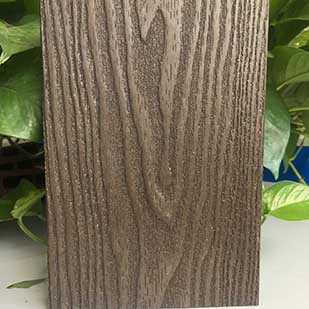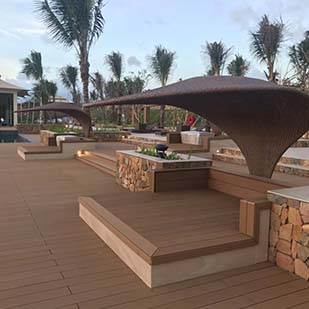Apr. 20, 2020
In recent years, the wood plastic composite material industry has made great progress both in terms of technology and application fields. From the perspective of performance optimization and cost control, wood plastic composite materials have also evolved from the first-generation to the current second-generation and third-generation products. At present, the latest research results of WPC composite materials mainly include co-extruded WPC(it is called capped decking in some countries), embossed WPC and 3D embossing WPC.

Co-extruded WPC products
Co-extruded wood plastic products are currently the leaders of the second generation of WPC products. The application of co-extrusion technology has reduced the cost of WPC composite products under the condition of unchanged performance, and opened up a new path for cost savings. There are more and more co-extruded products in the European and American markets, not only traditional high-end wood plastic doors and windows, handrails, and fences, but also low-end floors, fences, exterior wall panels, and formwork. Using wood plastic co-extrusion, the products accounted for more than 50% of the total wood plastic products, it can be said that wood plastic co-extrusion has become the mainstream trend of WPC products. At present,the co-extruded materials mainly include PVC, PE and acrylonitrile-styrene-acrylonitrile plastic (ASA), among which PE-based wood plastic co-extruded products have a relatively large output. At present, the domestic production of WPC products is mainly from recycled materials, so the application of co-extrusion technology becomes more necessary and urgent, otherwise
it will soon be eliminated by the market. The base layer of co-extruded products does not need to add anti-aging agents, pigments and other materials and the thickness of the co-extruded surface layer is about 0.5 mm.
Embossed wood plastic products
With the improvement of people's quality life, the single-color WPC can not meet the aesthetic needs of customers. People have higher requirements on the spiritual level, and they are more inclined to be close to nature. In order to achieve beautiful, practical, simulation, embossed wood plastic products are developed,which enriched the surfaces of composite wood products. Embossed products are more and more inclined to complex retro grain. At present, the most widely used techniques are antique embossed grain and 3D online embossing. Online embossing is commonly known as hot embossing, that is, embossing is performed before the temperature of the wood plastic profile at the mold mouth is not reduced, which largely retains the original pattern, increasing the visual and three-dimensional sense.The wood plastic industry has been pioneered and developed in the field of decoration.

Applications of wood plastic composite products
At present, wood-plastic composite materials have been widely used in the civil field. The products include interior decoration materials, such as door covers, door cover lines, skirting lines, shutters, wall panels and other decorative lines; and exterior wall decoration, outdoor decking, municipal facilities, packaging materials, household items, daily sundries, auto parts, etc. Due to the characteristics of light weight, high rigidity, acid and alkali resistance, waterproof and insect resistance, the wood-plastic composite material has no decoration problems such as formaldehyde and benzene, and can be recycled and reused. The application field is constantly expanding.

In E-Hong, as R & D personnel further develop and improve WPC products, WPC materials are made into more and more products and enter the lives of consumers. Globally, E-Hong is also opening up a new pattern of home decoration with new environmentally friendly home concepts and products.